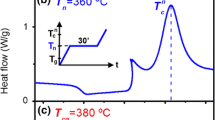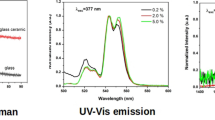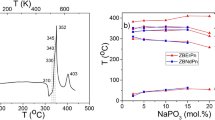Abstract
The preparation of oxyfluoroborate glasses and glass–ceramics doped with Yb3+ and Er3+ with improved luminescent properties is reported. Glasses with compositions (100 − x − y) (MO·2B2O3) + xPbF2 + y(YbF3:ErF3) (% in mol), where M is Sr, Ba, Ca, x = 10–40% and y = 0, 1 or 5% were prepared by the melt/quenching technique. Glass crystallization was studied using thermal analysis and X-ray diffraction techniques. Optical absorption and infrared up-conversion were studied on both glasses and glass–ceramics. The incorporation of a fluoride compound into the borate glass resulted to depend on the ionic radius of the glass modifier: as it increases, glasses become more stable against crystallization. On the other hand, alkali–fluoride compounds such as BaF2 and SrF2 can be crystallized from these systems by selecting an appropriate proportion between their components. Furthermore, the up-conversion response can be tuned by changing the glass modifiers (Sr, Ba and Ca) of the borate matrix, which also influence the type of fluoride crystallized compound. The strontium glass–ceramics have the highest luminescence response due to the crystallization of SrF2 compound in the system SrO–B2O3–PbF2. Meanwhile, the lowest luminescence signal was obtained for samples in the system BaO–B2O3–PbF2 where the Pb1.33Ba2.66B11FO20 phase crystallizes. With this strategy, new materials with improved luminescence properties that can be used as up converters, were obtained.






Similar content being viewed by others
References
X. Huang, S. Han, W. Huang, X. Liu, Enhancing solar cell efficiency: the search for luminescent materials as spectral converters. Chem. Soc. Rev. 42(1), 173–201 (2013)
W. Wang, H. Gao, Y. Mao, Highly matched spectrum needed for photosynthesis in Ce3+/Er3+/Yb3+ tri-doped oxyfluoride glass ceramics. J. Alloys Compd. 648, 75–78 (2015)
L. Wondraczek et al., Solar spectral conversion for improving the photosynthetic activity in algae reactors. Nat. Commun. 4, 2047 (2013)
M.C. Gonçalves, L.F. Santos, R.M. Almeida, Rare-earth-doped transparent glass ceramics. C. R. Chim. 5, 845–854 (2002)
C. Rüssel, Nanocrystallization of CaF2 from Na2O/K2O/CaO/CaF2/Al2O3/SiO2 glasses. Chem. Mater. 17(23), 5843–5847 (2005)
P.P. Fedorov, A.A. Luginina, A.I. Popov, Transparent oxyfluoride glass ceramics. J. Fluor. Chem. 172, 22–50 (2015)
A. de Pablos-Martín, A. Durán, M.J. Pascual, Nanocrystallisation in oxyfluoride systems: mechanisms of crystallisation and photonic properties. Int. Mater. Rev. 57(3), 165–186 (2012)
V.K. Tikhomirov et al., Optimizing Er/Yb ratio and content in ErYb co-doped glass-ceramics for enhancement of the up- and down-conversion luminescence. Sol. Energy Mater. Sol. Cells 100, 209–215 (2012)
J.C. Goldschmidt, S. Fischer, Upconversion for photovoltaics—a review of materials, devices and concepts for performance enhancement. Adv. Opt. Mater. 3, 510–535 (2015)
Y. Wang, J. Ohwaki, New transparent vitroceramics codoped with Er3+ and Yb3+ for efficient frequency upconversion. Appl. Phys. Lett. 63(24), 3268–3270 (1993)
G. Dantelle et al., Nucleation efficiency of erbium and ytterbium fluorides in transparent oxyfluoride glass-ceramics. J. Mater. Res. 20(2), 472–481 (2005)
F. Zeng, G. Ren, X. Qiu, Q. Yang, Effect of different Er3+ compounds doping on microstructure and photoluminescent properties of oxyfluoride glass ceramics. Physica B 403 (13–16), 2417–2422 (2008).
Y. Ledemi, M. El Amraoui, J.L. Ferrari, P.-L. Fortin, S.J.L. Ribeiro, Y. Messaddeq, Infrared to visible up-conversion emission in Er3+/Yb3+ codoped fluoro-phosphate glass-ceramics. J. Am. Ceram. Soc. 96(3), 825–832 (2013)
W.C. Wang, J. Yuan, X.Y. Liu, D.D. Chen, Q.Y. Zhang, Spectroscopic properties and energy transfer parameters of Yb3+/Tm3+ co-doped fluorogermanate glasses. J. Non Cryst. Solids 431, 154–158 (2016)
F. Steudel, S. Loos, B. Ahrens, S. Schweizer, Quantum efficiency and energy transfer processes in rare-earth doped borate glass for solid-state lighting. J. Lumin. 170, 770–777 (2016)
M. Rodriguez Chialanza et al., Correlation between structure, crystallization and thermally stimulated luminescence response of some borate glass and glass-ceramics. J. Non Cryst. Solids 427, 191–198 (2015)
K. Shinozaki, W. Pisarski, M. Affatigato, T. Honma, T. Komatsu, Glass structure and NIR emission of Er3+ at 1.5 µm in oxyfluoride BaF2–Al2O3–B2O3 glasses. Opt. Mater. 50, 238–243 (2015)
A.A. Cabral, A.A.D. Cardoso, E.D. Zanotto, Glass-forming ability versus stability of silicate glasses. I. Experimental test. J. Non. Cryst. Solids 320(1–3), 1–8 (2003).
A.C. Larson, R.B. Von, Dreele, General Structure Analysis System (GSAS) (Los Alamos National Laboratory, New Mexico, 1994)
B.H. Toby, A graphical user interface for GSAS. J. Appl. Crystallogr. 34(2), 210–213 (2001)
H.M. Rietveld, A profile refinement method for nuclear and magnetic structures. J. Appl. Crystallogr. 2(2), 65–71 (1969)
C.A. Gressler, J.E. Shelby, Properties and structure of PbO-PbF2-B2O3 glasses. J. Appl. Phys. 66(3), 1127–1131 (1989)
Y.D. Yiannopoulos, G.D. Chryssikos, E.I. Kamitsos, Structure and properties of alkaline earth borate glasses. Phys. Chem. Glass 42(3), 164–172 (2001)
C.G. Bergeron, Crystal growth kinetics in binary borate melts, in Materials Science Research, vol. 12, ed. by V.D. Fréchette, L.D. Pye, N.J. Kreidl (Plenum Press, New york, 1978), pp. 445–462
L. Shartsis, H.F. Shermer, Surface tension, density, viscosity, and electrical resistivity of molten binary alkaline-earth borates. J. Am. Ceram. Soc. 37(11), 544–551 (1954)
R.D. Shannon, C.T. Prewitt, Effective ionic radii in oxides and fluorides. Acta Crystallogr. B 25(5), 925–946 (1969)
J.A. Dean, Lange’s Handbook of Chemistry (McGraw-Hill, New York, 1934)
A. Marotta, A. Buri, F. Branda, S. Saiello, Nulceation and crystallization of Li2O-2SiO2 glass—a DTA study, in Advances in Ceramics. Nucleation and Crystallization in Glasses, ed. by G.H. Beall, J.H. Simmons, D.R. Uhlman (American Ceramic Society, Westerville, 1982), pp. 146–152
V.M. Fokin, A.A. Cabral, R.M.C.V. Reis, M.L.F. Nascimento, E.D. Zanotto, Critical assessment of DTA–DSC methods for the study of nucleation kinetics in glasses. J. Non Cryst. Solids 356, 358–367 (2010)
K. Matusita, S. Sakka, Y. Matsui, Determination of the activation energy for crystal growth by differential thermal analysis. J. Mater. Sci. 10(6), 961–966 (1975)
M. Środa, I. Wacławska, L. Stoch, M. Reben, DTA/DSC study of nanocrystallization in oxyfluoride glasses. J. Therm. Anal. Calorim. 77(1), 193–200 (2004)
M. Mortier, G. Patriarche, Structural characterisation of transparent oxyfluoride glass-ceramics. J. Mater. Sci. 35(19), 4849–4856 (2000)
H. Wu et al., Designing a deep ultraviolet nonlinear optical material with large second harmonic generation response. J. Am. Chem. Soc. 135(11), 4215–4218 (2013)
D.P. Kudrjavtcev, Y.S. Oseledchik, A.L. Prosvirnin, N.V. Svitanko, Growth of a new strontium borate crystal Sr4B14O25. J. Cryst. Growth 254(3–4), 456–460 (2003).
B. Lai, L. Feng, J. Wang, Q. Su, Optical transition and upconversion luminescence in Er3+ doped and Er3+–Yb3+ co-doped fluorophosphate glasses. Opt. Mater. 32(9), 1154–1160 (2010)
V.D. Rodríguez, V.K. Tikhomirov, J. Méndez-Ramos, A.C. Yanes, V.V. Moshchalkov, Towards broad range and highly efficient down-conversion of solar spectrum by Er3+Yb3+ co-doped nano-structured glass-ceramics. Sol. Energy Mater. Sol. Cells 94(10), 1612–1617 (2010)
M. Azam, V.K. Rai, P. Mishra, Enhanced frequency upconversion and non-colour tunability in Er3+–Yb3+ codoped TeO2–WO3–Pb3O4 glasses. J. Mater. Sci. Mater. Electron. 27(12), 12633–12641 (2016)
T.S. Goncalves et al., Structure-property relations in new fluorophosphate glasses singly- and co-doped with Er3+ and Yb3+. Mater. Chem. Phys. 157, 45–55 (2015)
M.-Y. Yoo, J.-H. Lee, H.-M. Jeong, K.-S. Lim, P. Babu, Enhancement of photoluminescence and upconversion in Er–Yb codoped nanocrystalline glass–ceramics. Opt. Mater. 35(11), 1922–1926 (2013)
F. Steudel, S. Loos, B. Ahrens, S. Schweizer, Luminescent borate glass for efficiency enhancement of CdTe solar cells. J. Lumin. 164, 76–80 (2015)
Acknowledgements
This work was supported by the “Agencia Nacional de Investigación e Innovación” (Project Number ANII-PR-FSE-12013-1057), the “Comisión Sectorial de Investigación Científica” (CSIC), the “Programa de Desarrollo de Ciencias Básicas” (PEDECIBA), and the Brazilian agencies: FAPEG, CNPq and CAPES.
Author information
Authors and Affiliations
Corresponding author
Electronic supplementary material
Below is the link to the electronic supplementary material.
Rights and permissions
About this article
Cite this article
Rodríguez Chialanza, M., Keuchkerian, R., Maia, L.J.Q. et al. Development of oxyfluoroborate glass ceramics doped with Er3+ and Yb3+. J Mater Sci: Mater Electron 29, 5472–5479 (2018). https://doi.org/10.1007/s10854-017-8514-x
Received:
Accepted:
Published:
Issue Date:
DOI: https://doi.org/10.1007/s10854-017-8514-x




